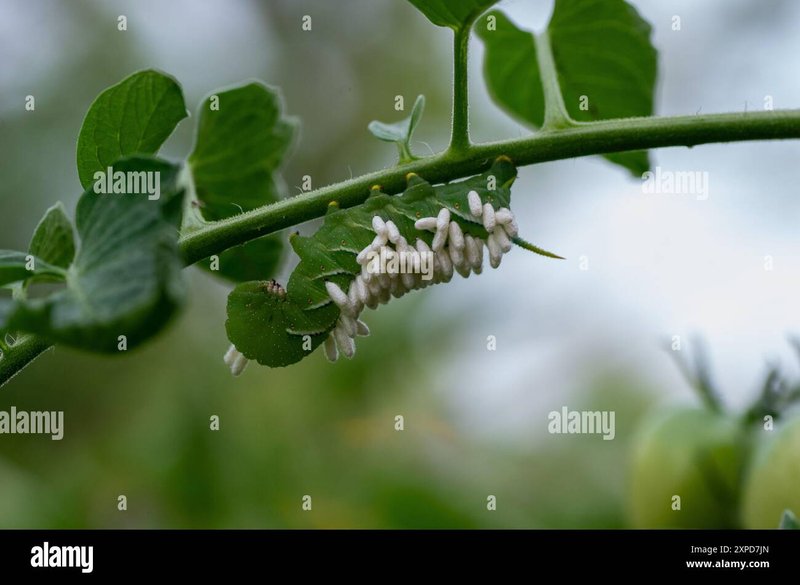
Imagine you’re examining a hornworm in your garden, and you start noticing things that seem a bit off. Maybe it has tiny holes or looks a bit too lethargic. That’s when you might start to wonder, “Is something wrong with this guy?” Understanding the signs of parasitism in hornworm larvae can help you identify whether they’re just ordinary caterpillars or if they’ve been hijacked by a parasite.
Let’s dive into the intriguing world of hornworm larvae and the signs that can indicate parasitism.
What Are Hornworms?
Hornworms are the larvae of certain moth species, particularly the *Manduca sexta* (the tobacco hornworm) and *Manduca quinquemaculata* (the five-spotted hawk moth). They’re famous for their bright green color that helps them blend in with the foliage of plants. These guys can grow quite large, reaching lengths of up to 4 inches. In many gardens, they’re often found munching on the leaves of tomato, pepper, and eggplant plants.
But why should you care? Well, while they can be a gardener’s nightmare, they’re also fascinating creatures that play a key role in the ecosystem. They eventually transform into beautiful moths, and their life cycle is a great example of nature’s wonders. However, sometimes they become hosts for parasites, leading to noticeable changes in their behavior and appearance.
Recognizing hornworms is the first step in understanding whether they’re merely pests or if they’re being affected by parasitism.
Common Signs of Parasitism
When you’re looking at hornworm larvae, there are several signs that can indicate they’ve been taken over by parasites. Here’s what to keep an eye out for:
- Small holes in the body: If you notice tiny holes along the sides of the hornworm, this could mean that a parasite is feeding on them from the inside. It’s a bit gruesome, but it’s nature’s way.
- Lethargy and sluggish movements: Instead of munching away on your plants, a parasitized hornworm might appear slow and tired, struggling to move about.
- Change in color: Healthy hornworms are a vibrant green, but those affected by parasites might have a duller hue. This change can be a sign they’re not getting the nutrients they need.
- Signs of pupation: If you see a hornworm that seems to be turning into a cocoon or has weird growths, it’s often a sign that a parasite is preparing to emerge.
These behaviors are like red flags waving in the wind, signaling that something is amiss.
Types of Parasites in Hornworms
Now that you know what to look for, let’s take a closer look at the types of parasites that often target hornworm larvae.
The most notorious culprits are parasitic wasps, particularly those from the genus *Cotesia*. These wasps lay their eggs inside the hornworm, and once the larvae hatch, they feed on the host from the inside out. Talk about a horror movie scenario!
Another notable parasite is the baculovirus, which can infect hornworms and cause them to behave strangely before ultimately leading to their demise. When a hornworm is infected with a baculovirus, it often stops feeding, becomes lethargic, and may even succumb to the effects of the virus, leading to a tragic end.
It’s fascinating how nature works, isn’t it? While it may sound cruel, it’s all part of the intricate web of life.
The Life Cycle of a Parasitized Hornworm
Understanding the life cycle of a hornworm that has fallen victim to parasitism can shed light on what happens next. Here’s how it typically unfolds:
1. **Egg Stage:** A female wasp lays eggs inside the hornworm. This is when the trouble starts.
2. **Larval Stage:** Once the eggs hatch, the wasp larvae begin feeding on the hornworm’s insides. At this point, the hornworm might start showing signs of distress—think lethargy and those tiny holes we talked about earlier.
3. **Pupal Stage:** After consuming enough of the hornworm’s nutrients, the wasp larvae will eventually leave the host to pupate. This stage is marked by strange behavior as the hornworm tries to escape its fate but often can’t.
4. **Adult Wasp Emergence:** Finally, the adult wasps emerge from the hornworm, ready to find new hosts and continue the cycle.
It’s like a twisted version of a nature documentary, but it showcases the circle of life in the wild.
How to Deal with Parasitized Hornworms
If you spot signs of parasitism in hornworm larvae in your garden, you might be wondering what your options are. Here are some approaches to consider:
- Leave them alone: If the hornworm is parasitized, it may not pose a threat to your plants anymore. In fact, the wasp larvae are often beneficial, as they can help control hornworm populations.
- Handpicking: If you prefer to take action, you can carefully remove hornworms from your plants. Just be aware that this might not be a long-term solution since new hornworms can appear.
- Encouraging beneficial insects: Introducing natural predators like birds or beneficial insects like ladybugs can help keep hornworm populations in check without harming the ecosystem.
Ultimately, it’s about striking a balance between protecting your plants and understanding the role of these creatures in nature.
Understanding the signs of parasitism in hornworm larvae is not just about protecting your garden; it’s also about appreciating the intricate relationships in nature. Although it can be unsettling to see these signs, it’s a fascinating reminder of how life can be interconnected in surprising ways.
The next time you encounter a hornworm, take a moment to observe it. Is it acting normally, or does it show signs of being parasitized? Whatever you discover, you’ll be armed with knowledge that enhances your experience in the garden. Plus, you can share this newfound understanding with others, helping to spread awareness about the delicate balance of our ecosystems. Happy gardening!

